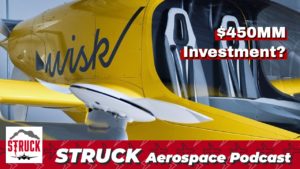In episode two, Allen discusses some of the unique lightning protection technology that’s now found on aircraft, including new materials–such as woven wire carbon fiber–that can help protect from lightning strikes.
Learn more about Weather Guard StrikeTape segmented lightning diverter strips. Follow the show on YouTube, Twitter, Linkedin and visit us on the web. Have a question we can answer on the show? Email us!
Podcast: Play in new window | Download
Transcript
Dan: Welcome back! This is episode two of the Struck Podcast. I am your co-host Dan Blewett. I’m here visited remotely by lightning protection expert and CEO of Weather Guard Lightning Tech, Allen Hall. Allen what’s going on?
Allen: Hey Dan, how’s it going there in Washington DC? Are you guys getting some sunny weather down there finally?
Dan: It was beautiful today. I’m going to go run later. I try to run in straight lines on the sidewalk till I see a human, then take a sharp left into traffic to avoid them breathing on me or me breathing on them.
Allen: What’s the etiquette rules there when you approach someone running the opposite way? Does everybody just go to their right? Do they do the opposite in the UK? How does that work?
Dan: I subconsciously hold my breath. I’ve noticed myself doing it like I don’t want to breathe your air in, don’t breathe my air. Everyone keep your air to yourself. Also you can see the subtle movements of people starting to get out of your way. Sometimes it’s not subtle and that’s fine, no one’s getting offended. I think people are friendlier. I think I’m giving people a nod, people are making eye contact with me. We’re all like “hey, thanks for staying six feet away”. We appreciate each other. There’s honestly a vibe from that, which isn’t surprising. I feel like most Americans and most people around the world right now know that we are in this together. We understand the rules. I’m going to stay away from you out of respect, and you do the same. There is that kind of feeling here in the city, which I think is kind of nice. There’s a little bit of a neighborly feel to it, which is good.
Allen: Well, you’re kind of in an epicenter as we keep hearing on the news.
Dan: We’re a very diverse city, the capital of the United States. But we don’t have any cases yet, which is good. It seems like it’s only in the three hundreds.
Allen: Well that’s not bad for a city of that size quite honestly. New York City is really taking the brunt of it right now. The cases there are scary.
Dan: DC–I don’t know the population here but–it’s not a big city. There’s a huge metro area, like it’s an epicenter. The traffic is disproportionately large to the population, but I think there’s only maybe a 700,000 DC population.
Allen: Officially in the district, is that what it is? It’s not a very large area.
Dan: It’s a very walkable city. Kind of like a three mile radius, it’s nothing like Chicago which was my epicenter living in Illinois the last ten years. Chicago is very big, and of course New York is so much bigger than that. It’s been interesting.
Allen: Are people wearing masks down there? Have you seen anybody jogging with a mask? Or is it pretty much keeping your distance. Cause I’ve seen more masks in the last three or four days than I’ve seen in a long time.
Dan: What about you? You’re up in the wilderness. It’s beautiful up where you are in Williamstown, but what’s your situation? Do you guys have a good amount of masks or a little bit?
Allen: It’s weird. We’re so sparse out here that people that are running around are mostly without masks. When I saw one the other day I thought “wow that’s unusual”. We went to the next town over, getting out of the house and driving somewhere to try and help everybody get through sanity, and people were wearing masks. And I thought well it’s probably a smart move, particularly if you’re in those vulnerable categories, to throw a mask on. And as we’re testing we’re finding out there’s a lot more cases up here than we thought there was. But I think it’s smart to wear the mask if you have it I suppose. All the doctors and nurses are obviously in need of those first, but some of the face coverings are interesting. You kind of wonder if it’s going to become more acceptable, particularly in the States because it’s not acceptable in the States. It’s a cultural thing I think when you especially see it on an airplane. People do not wear masks. I think people take it as a sign that you’re really sick, so everybody kind of scoots away from someone who’s wearing a mask. It’s kind of a weird dynamic. I kind of wonder if that’s going to change over time because we’re all interconnected. We’re all traveling across the world all the time anymore. It doesn’t take any time for any disease to travel.
Dan: To answer the question, I’d say most people are not wearing them, but there’s a good amount where you notice them consistently. I mean if I’m walking in an area where there’s a bunch of people around, which I’m not in areas like that often, but if I’m walking down the sidewalk and I see people across the street or at the grocery store there’s a good percentage of masks. I couldn’t tell you what it is. It’s probably less than you’d think, but you notice them all so you pick up on them. But it’s maybe 10 to 20 percent, but in the grocery store that’s 30-40 people.
Allen: Don’t you think that’s had an American cultural thing not to wear it? It seems unusual because I think in some countries it’s more accepted.
Dan: I don’t know if it was this year or in the past I noticed some Asian Americans–or just Asians whether they’re tourists or whatever– wearing masks before this epidemic or this pandemic. At various times, whether it’s flu season, the only person you would ever see wearing a mask would be an Asian person. With the SARS outbreak I mean it was a very serious problem so that made a lot of sense. DC is a very diverse city, and there’s no difference here of who’s wearing them. If you’re white, black, Asian it doesn’t matter. There’s no difference and I thought about that. I’m like should I wear a mask? How would I feel about wearing a mask? And I felt weird about it, but at the same time, you’re just trying to protect yourself. Of course I have no access to anything. I was super excited – I bought bleach last night.
Allen: Oh wow! You actually found bleach.
Dan: There were two jugs tucked away in the bottom shelf of Target. I went there because I needed a piece of hardware for the podcast for some sound proofing. Target’s big and I expected it to be pretty busy. It was like 7:45. It was a ghost town, and they have a full grocery store in this one. I figured Target was going to be much busier than the local grocery store, but it was the exact opposite. It was very sparse which was surprising to me. I hadn’t gone to Target since, and this has been a big thing for me.
Allen: Well I guess it’s good that people are staying home. If you don’t need to be out, don’t be out, that’s what we’re being told right now. Until things calm down that’s probably a good choice.
Dan: I mean every store is different in their protocols, so I personally think a lot of people have their personal brands. Brands that you would choose whether it’s your brand of cottage cheese, or the type of shirts you buy, whether you wear Nike or Adidas shoes, whatever. But Costco, I really respect their company and their leadership. The way they price things, the quality of their foods, it seems like they take care of our employees. I jumped on the Metro a week and a half ago and went to Costco and everyone’s like you’re going to go to Costco? But of all the places I could get groceries in this pandemic, I really trust Costco more than other places to do things right and like keep their customers safe. And put good systems in place and really clean things. When I showed up there was a really long line outside, and it was for that exact reason. They were limiting how many customers could go inside, They were meticulous. If a person gave you a cart, they wiped it off for you, then you’re on your way in the store. They were curating the lines. They did a really impressive job of exactly what you should be doing. I think their leadership made a plan and said this is how we make our stores safer and have less employee interaction because they don’t want their employees being too close to you either for everyone’s safety. They’re one of those companies that I think that–I’m not saying other companies aren’t doing this too–but it was very organized, very systematic, very well-thought-out I felt. I went to Costco and people were like don’t go there, but you had enough space. They had a really good stock of things. And another thing, they had a big whiteboard outside and it said here’s things we don’t have in stock and here’s what we do have in stock. You don’t have to go in there if you need toilet paper and they don’t have it. You’re going to see it right outside.
Allen: They’re not wasting your time.
Dan: I was really impressed with them. I think a lot of companies are really working hard to try to help customers with what they need as safely as possible.
Allen: I saw that today with some of the airline things that are going on, because there are some airlines that are still flying and on limited capacity. The effort they’re going through to make sure the airplanes are clean, and the pilots and the crew are in safe conditions. So they’ve established procedures to keep everybody distanced. They’re doing cleaning techniques to clean the airplanes and that kind of thing. I was surprised at the level of detail there, at least in this one in particular I saw. They were taking everything into consideration. It is similar to things I’ve seen happen on subways actually. You don’t think about how much effort it takes to clean an airplane, but it takes a lot of effort. There’s a lot of services there obviously. I know that there may not be a lot of passengers, but still it doesn’t really matter. You’re going to have to clean it all, and it was really fascinating to watch how quickly the airlines had responded to that and were able to put measures in place. The other thing that’s happening is they’re parking a lot of airplanes. I saw it down in Tulsa Oklahoma today. I think it was American. American was parking airplanes on the tarmac on the runways just to keep airplanes somewhere warm and safe while everything is going on. It’s depressing to see the number of airplanes parked, but it’s encouraging in this sense. They’re not parking them out in the desert and going to put them away. They’re intending to bring those airplanes back in a couple of weeks. Hopefully we can be up back and running, obviously not at full strength for the airlines. It’s going to be a little bit of a hesitancy to do that, but hopefully over the next couple of weeks we can see a big difference. Obviously everybody keeping their distance from one another now is going to make a big difference three weeks from now.
Dan: The Metro is something that my sister doesn’t want to take. I’m like okay, but the Metro is such a ghost town. I walk down, don’t touch a single thing, touch my MetroCard to the scanner, it lets me through the gate, I stand there and don’t touch anything. I get in my car. I’m the only person in that car. I sit down until the doors open and close for you, get off, and I have gone through my metro ride without having to interact with a human. It’s not like that in every mode of public transportation though. I watched a city bus go by the other day and it was 2/3 full of people, and I’m like I’m not doing that.
Allen: That’s a bus – it’ll be hard. But I even remember when I was recently flying across the country, I took Southwest Airlines, and it is one of those things you don’t really pay attention to until you start thinking about it. I realized like I’m not interfacing with a human here hardly at all until I get through TSA. I don’t really interact with a human, in fact I can bring all my stuff in on my phone so I can have my boarding pass on my phone. If I don’t have any luggage I can go right to the gate. There’s really no human interaction or exchanging like it used to be in the past. All that’s changed a lot, and I think we’re probably going to see more of that quite honestly as we go forward. Less exchanging of things between humans is one way to cut down on some of the virus spread. If we design the systems a little bit differently, we can cut down on some of the contamination that’s going on. It’s going to be interesting to see it.
Dan: Well, you wonder if some of these general human interactions like greetings or handshakes are going to come back. Are people going to be shaking hands when this is all mostly over, with life back to normal like in July or August? Are people going to be shaking hands?
Allen: I guess it depends on the situation. In the United States it’s really a cultural thing, but in some places is a world it’s not. Cultural things come and go with time, depending on the outside environment. and this is one of those things that’s probably going to change. I think obviously as we all raise kids in the States that’s one of the things: have a good handshake. That’s something for sure in job interviews, a good shake.
Dan: If after an interview you have a really good handshake, but then you immediately pull out hand sanitizer afterwards. Where does that get you?
Allen: People used to be criticized for that quite honestly. There’s politicians that were criticized for doing that and some business leaders were criticized for doing that, but if you think about it from their point of view, if you’re interfacing with a thousand people at a conference or somewhere like that, pretty much every disease in the world is going to be on your hands. And if you want to remain somewhat healthy, washing your hands is probably the best thing and then putting hand sanitizer on is probably a decent second. But in some cases years ago it used to be insulting. I don’t think that’s insulting anymore. I think that’s going to be more of the norm. You can see a lot more of the purell things and little hand squirter things that knock down the virus, and it saves lives.
Dan: We should be doing it. Speaking of things that vaporize things, lightning. One of the topics we want to cover today is how much energy is in a typical lightning strike that hits a plane or helicopter or blimp. Or say the Oscar Mayer Wienermobile is driving down the highway and gets struck by lightning. What are the typical strikes that any aircraft is going to take?
Allen: The FAA requirements are interesting because–this concept came up again last week at the design project that I’m working on–of energy density and how much energy is in a lightning strike. And how do we best mitigate it? I used to work at a lightning test lab down in Pittsfield, Massachusetts. It was formerly called Lightning Technologies. It’s called National Technical Services (NTS) now. When I worked in the lab there, one of the common questions when we had a visitor come in to run some testing was, “Do the lights dim when you turn on the generator?” No they don’t, actually. I hadn’t really thought of it that way, but there’s not that much energy, total energy in a lightning strike, particularly when we were trying to recreate it in a lab. It doesn’t require additional power feeds from the power company. The lights don’t dim, and none of that happens. It’s a measure of how fast you take the energy and discharge it, and that’s where the power of lightning comes from. If you have a big bucket of energy and you spread it out over time, that amount of energy is not going to do much. But if I jam all that energy into a very small space in a very short amount of time, things get explosive. That’s the kicker for lightning, and they’re getting that concept. It may not be huge buckets and tons of energy, but we’re putting it into a very small space. How we design our aircraft parts has a lot to do with how much damage they will see. There’s a good rule of thumb for companies that haven’t done a lot of testing or have a lot of experience with carbon fiber. Carbon fiber in particular is a little bit of a treacherous design exercise. The carbon fiber’s resistive, but when you make carbon fiber structures if you don’t paint it, it’ll do pretty well actually because the lightning energy actually spreads out over the surface of the part. When you paint it with some polyurethane or aircraft paint epoxy, whatever it is, what those paints and coatings tend to do is focus energy into a very small area. That’s one thing that carbon fiber composite doesn’t like is a lot of energy in a very small area. What we do for composite airplanes in particular is we end up putting some metal foils or in some cases what we call innerwoven wires in the carbon fiber. I’ll talk about that in a minute, but essentially what we’re trying to do is spread the energy out over a larger area. Now, this has implications on the size of the airplane. Call me company B, and I’m building a large transport aircraft. It’s going to hold 200 people. That aircraft can be fairly good-sized, so any carbon fiber structure I design there, because the structure is big and weighty and massive, there’s a lot of carbon fiber there. From a lightning standpoint it doesn’t really matter all that much what kind of coatings I put on it because the structure is so thick that the carbon fiber can handle it. When I build a small airplane, like a small business jet like you see today, or some of these like transport things that are popping around–self-guided things that are going on– those are much lighter, thinner structures where there may be a lot of carbon fiber typically. The energy density is strong there. Because the structures are much thinner, any coating you put on it has a lot to do with how much damage it takes. When you see a big airplane get struck by lightning, that’s a decent amount of damage. If you put that same amount of damage into a much lighter structure that’s used on a smaller aircraft, it causes a much bigger damage area. That’s the trick when you get a design. When I get a design project and it’s on a big aircraft I think “this is easy”. When I get a small aircraft, like a three or four person kind of airplane, and it’s made out of some carbon fiber, I know it’s going to be a long haul. Just because of that reason.
Dan: Is there any way to get around that? Obviously you can’t have all these carbon fiber parts uncoated because I’m sure there’s a lot of effects with it. What balance can you find there in terms of the materials? Can you leave them more unpainted? Is there some alternative coating?
Allen: There’s a number of different things that we do that are standard. Probably the most common one is what we call expanded metal foil. These are thin foils, they may be a couple thousandths of an inch thick, and they’re perforated. We perforate them for a couple of different reasons, but it allows it to be glued to the airplane. It also can be a little more flexible. That material actually is a derivative of things they use to make capacitors with. If you look at your power poll out the street, you probably have a canister out there. That’s full of this expanded metal foil in a big coil to make a capacitor. That’s what it’s used for for the most part. They use it on airplanes too because it puts conductivity back into the airplane. Expanded metal foil does a good job of helping spread out the lightning energy and keep it out of the carbon fiber a little bit. The other thing that it does is when lightning energy hits it, because it’s so thin– it’s only a couple thousandths thick– it tends to vaporize. When it vaporizes, it actually explodes the paint off around it. It gets about a 12 inch diameter area where the paint has been exploded off. The lightning energy reaches over that area and you get less localized damage. It’s going to spread over a larger area. That’s the most common one. One of the lightest weight ones–and with airplanes everything’s about weight–is interwoven wires. And interwoven wires originally started off as four thousandths of an inch diameter wires that are woven with the carbon fiber fabric. As they actually make the carbon fiber fabric, you put these little wires in and there were about 10 or 12 wires per inch. It makes this metal grid if you look at it. It was developed on the Lear fan. The Lear Fan was an early composite…it was a pusher propeller airplane. The same technology was then used on the Beech Starship. Essentially you’ve got these little metal wires that are woven into the carbon fiber and when lightning hits that, those little metal wires expand and they tend to melt and vaporize out. What happens is you get a grid of exploding aluminum wires that shoot out. What it does is it takes the paint off the carbon fiber and allows the lightning energy to spread out. It uses some of the early lightning current to remove the paint so that the subsequent lightning current, where the big energy is, is spread over a larger area. It significantly reduces the lightning damage, particularly on these very thin, critical structures that are in smaller business type aircraft. It’s a really interesting material, I did a lot of work with it a long time ago. It’s very lightweight, it’s very efficient as a lightning protection material. You still see it used on a variety of business jets, and I think the 787 was using a derivative of that. I haven’t followed the 787 lately, but I think they were using a derivative of that. Then some other things that are coming up more recently are conductive coatings or paints. They seem to be getting a little part of the market share. There are some advantages to it–basically when the airplanes are done, they paint it with something conductive and then put a top coat of paint on it and call it done. There’s advantages to that. Simplicity, being able to control it a little bit. The problem comes about later on as you repair it. What happens if I scratch it, do you have to take the top coat of paint off to get in to fix this stuff? It’s all about the repair side, and there’s never a great answer for any of those, quite honestly. If you take a lightning strike, it’s going to be expensive to fix, period. But it’s all about training. If I’m out in a remote part of the world and I’ve got this very unique coating on the airplane, can I get it fixed? Does the maintenance depot I’m at know how to do this? Probably not, right. That’s where things like expanded metal foils come in because pretty much anybody can do it anywhere with a little bit of training. There’s kind of a trade-off. That’s the interesting trade-off that’s going on now.
Dan: Two thoughts popped into my mind as you’re talking about that. Did you finish the book called “Every Tool’s A Hammer” by Adam Savage? Did you finish that audiobook?
Allen: Yes, I did actually. I really liked it.
Dan: One of the things he talks about… if you’re not familiar with Adam Savage he is one of the two Mythbusters. He’s the guy…he’s the not bald one. I’m trying to think of his hair color. I guess he’s kind of red. Adam Savage’s book is called Every Tool’s a Hammer, and he talked about creating things. He covers glues and fasteners, and in one of his later chapters he’s talking about fasteners. He’s talking about it because he makes reproductions of all these different movie props. That’s what he nerds out on. He was talking about this device from the movie Hellboy. It was the mecha glove. But he was referencing and saying when you’re choosing fasteners you could rivet it, you could glue it, you could weld it, you could bolt it. He’s like these are important questions, and this is back to your talking about repairs. When you’re building this, if it gets damaged what fasteners did you use, and how do they affect how you’re going to repair this? If you help make this all out of the factory, and it’s all pressed together and welded together and glued together, if something suffers damage, the whole things going in the trash. And he was talking about how one of his reproductions–it might’ve been that crazy Hellboy glove thing–he was saying how when he got deep into the design, he had used all bolts. To completely disassemble it, he said, if we hadn’t done that we would have been completely screwed at one point when he snapped off a part, or something broke in the assembly. It’s just interesting.
Allen: It’s exactly like when we’re all designing airplanes. Especially on larger planes. You can do a lot of maintenance on it, but it’s going to be flying for 30-40 years. There’s the maintenance aspect, and how can you repair it? Is it something that you can repair? There’s theoretical repair, and there’s actual repair. The theoretical repair is like – there’s a bolt there. If I just loosen this bolt, it’s all going to come apart and fix it. The actual repair is like – can I get my fingers and my tools in this area to physically get that bolt out? Yes or no.
Dan: Don’t get me started on that. I used to repair cars in high school. Some of the most angry I’ve ever been was trying to dislocate my elbow to get down into the engine bay to get it out. Good grief.
Allen: We have a place where usually every airplane has a place called the hell hole. The hell hole is a place where it’s just crammed, and there’s no place to sit in there. You put your knees on equipment, and it’s hot. You’re working in the dark, or you’re trying to fix things. There’s always a hole in the rear of the plane and for whatever reason we haven’t gotten away from that. It’s like a rite of passage for some reason, but the maintenance of those things is a nightmare. It’s a nightmare. There’s so many systems jammed in a small space, and it’s just crazy.
Dan: Back in the day, it was the same thing in airplanes as it was with cars. Back in high school I had a 67 Bronco and my brother had a 65 Mustang that we worked on. There was so much extra room in the engine bay. Those things were easy to work on compared to how it’s hard to change your oil in a car today. It’s frustrating! When I was 17 I took my engine out, I replaced my clutch, I replaced my transmission. I replaced all these parts. Now I’m 25, older and wiser, and I can’t even change my own oil! This is a stupid! I’m going home!
Allen: It’s gotten more complicated. This does kind of go back to an earlier discussion we were having about making things more efficient and green right. Part of that consequence in order to do some of those things is that we have to pack in a lot more technology to make things more efficient. That means it just makes it harder to deal with. The same thing exists on airplanes. It’s the same exact thing on aircraft where we’re trying to make them lighter. We’re trying these advanced materials. We’re trying to save energy. We’re trying to make it do a lot of different things. The thing that gets left out is, how are we going to fix this thing. That gets back to even things like on lightning strike damage. One of the things on lightning strike damage I say to all the companies all the time is, “Okay, cool. This design works. How the heck are we supposed to fix it when it takes a lightning strike? I want everybody to think about that for a second. If we’re in Anchorage, Alaska, and I take a lightning strike, and it’s July, how long is this airplane going to sit in the tarmac before we can get it fixed? That’s the reality of the situation. I know Anchorage, Alaska is probably an easy place to get things fixed today because we fly everywhere in the world. It’s a deep take and pause a minute. I can design really cool stuff, but if I can’t fix it in some remote part of the world, then it’s pretty much worthless. I need to go back to the drawing board and think about that for a little bit.
Dab: And the other thing is, you probably have experienced this just the same. One year I was driving across the country, and I had to be in New Jersey on a Friday. It was a Tuesday, so I gave myself some cushion. It was a two-day drive. My car, which was getting older, was paid off. In the middle of Janesville, Ohio I hear a screeching sound and start seeing a gauge drop. I blew a belt. I blew my alternator belt because my air conditioner pump seized, I later learned. So I’m driving, and I’m aware that I have to get off the road. The battery’s going to run out anytime. It’s not charging. I take the first exit, and this wasn’t one of those good exits where there’s a bunch of stuff around. I’m just wandering some back road. I don’t know where this is taking me. This is not good. When you’re really low on gas and you take an exit like that, you’re like oh no! It may be five miles, maybe 10 miles. I’m going to push my car there? So I pull up to this little – and I mean it was eight inch tall grass, there were old beer cans and 30 packs of beer and six engines rusting in the front of this – little old car shop. I walk up and I’m like, “Hey! Is this an auto repair shop?” I was expecting to see some guy like sleeping with his cap over his eyes. It was a blessing because in this little shop they were used to jerry-rigging things and making it work. If I had ended up at an official Honda dealership it would be like, “We can get both on order. It’s going to be $1700.” These guys were like, “That’s a weird belt. We definitely don’t have that serpentine belt for your Honda.” But they rigged up two belts and made it work. I drove 500 miles on it. I made all the way out there. They said, “ When you get there, go get the correct belt, and you need to get your air conditioner replaced.” I think they bypassed it. My air conditioner pump was seized, so I think they bypassed it somehow. They just got my alternator to keep turning.
Allen: Bypassed the air conditioner. Sure, it’s going to get warm, but you’ll have power.
Dan: When you talk about repairs and some of these mechanics being nimble and able to fix stuff – it was a tumultuous Drive.
Allen: It builds character. That’s what they say, it builds character. When you’re going through it it doesn’t build it a character, it builds a lot of rage.
Dan: I don’t want more character! I have enough character! I’m full of character right now! Obviously, in your designs, you’re trying to not only consult with engineers to have their plane adequately protected, but also to be able to nimbly get back in the air should they have an issue.
Allen: I think that’s the key. Especially in today’s world. It used to be, years ago, they had a lot more mechanics. As airline ticket prices have gotten less quite honestly, they’ve got to be a lot more nimble. Having downtime on an airplane is a big issue. I’ve had that discussion recently with some radome customers about how quickly you can get the airplane back in the air. You can’t have failures of non-essential equipment on an airplane, particularly if it’s a tv/satcom radome. If you have a problem on a piece of non-essential equipment that grounds an airplane, the airline officials get really angry really fast, because it’s something that they don’t need to fly. Every missed flight, I believe in Europe there’s penalties for that. They don’t consider a lightning strike to be one of those acts of God anymore, so they have to pay the passengers for the delay. That is starting to happen in the States more too. It’s becoming more and more important that lightning is a foreseen condition. I think that’s how I have seen it described recently in the European Union; lightning is a foreseen condition. You should be designing for it. That’s right. It makes sense. We know it’s going to happen.We have regulations that say it’s going to happen. The regulations don’t say that the airplane needs to continue flying without having any repair. In fact it actually kind of says the opposite. You need to be looking at the damage. Obviously you’re going to look at the damage. That’s a clear thing that’s going to have to happen. You have got to look at the damage. But if you do the walk-around, you do all your safety checks, everything looks good you want to put that airplane back into service. What you don’t want is what has happened in a couple of incidents recently. They’ve done the walk around and got this damage. I’ve got to get a new party in here. It’s not going to come until tomorrow. I’ve got to get another airplane over here, so I can get the passengers out on time. That kind of thing makes airlines nuts, and rightly so. Having that happen to me as a passenger a couple years ago, it’s really frustrating when something simple like that goes down.
Dan: For sure. Allen, episode 3 coming up we’ve made it through two! Good work both of us! For all of you out there in podcast land, whether you’re listening on iTunes, Spotify or Stitcher, which we’ve heard is having a little bit of trouble getting new feeds right now. They’re struggling. We appreciate your listening. Be sure to look for us here on again YouTube, iTunes, Spotif, anywhere you listen to podcasts, we’re going to be out there. Be sure to, if you haven’t already, check out our new updated website. WeatherGuardAero.com is our website where you’ll find this podcast as well as a number of helpful lightning articles, some great videos, a lot of new content that we’re putting out. If you need help with your radome designs, if you need help with really any aspect of your lightning protection you’re going to find a lot of good resources at WeatherGuardAero.com so definitely check that out. We’re proud of the work we put in, and we hope it’s helpful to you. If you need something, if you would love to see content on this topic or this topic, drop us a line info@wglightning.com or shoot us a message through the website, and we’ll get on that. Allen, thanks so much!
Allen: Thanks, Dan!
Dan: We’ll see you next week!












